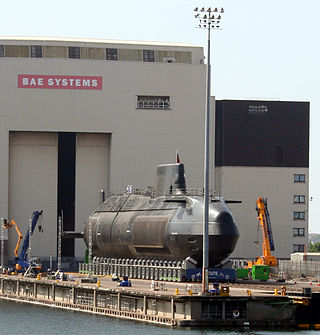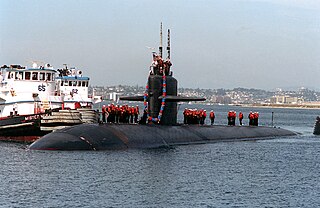
The Benjamin Franklin class of US ballistic missile submarines were in Navy service from the 1960s–2000s. The class was an evolutionary development from the earlier James Madison class of fleet ballistic missile submarine. Having quieter machinery and other improvements, it is considered a separate class. A subset of this class is the re-engineered 640 class starting with USS George C. Marshall. The primary difference was that they were built under the new SUBSAFE rules after the loss of USS Thresher, earlier boats of the class had to be retrofitted to meet SUBSAFE requirements. The Benjamin Franklin class, together with the George Washington, Ethan Allen, Lafayette, and James Madison classes, comprised the "41 for Freedom" that was the Navy's primary contribution to the nuclear deterrent force through the late 1980s. This class and the James Madison class are combined with the Lafayettes in some references.

The Ohio class of nuclear-powered submarines includes the United States Navy's 14 ballistic missile submarines (SSBNs) and its four cruise missile submarines (SSGNs). Each displacing 18,750 tons submerged, the Ohio-class boats are the largest submarines ever built for the U.S. Navy. They are also the third-largest submarines ever built, behind the Russian Navy's Soviet era 48,000-ton Typhoon class, the last of which was retired in 2023, and 24,000-ton Borei class. Capable of carrying 24 Trident II missiles apiece, the Ohio class are equipped with just as many missiles as, if not more than, either the Borei class (16) or the deactivated Typhoon class (20).

The Sturgeon class was a class of nuclear-powered fast attack submarines (SSN) in service with the United States Navy from the 1960s until 2004. They were the "workhorses" of the Navy's attack submarine fleet throughout much of the Cold War. The boats were phased out in the 1990s and early 21st century, as their successors, the Los Angeles, followed by the Seawolf and Virginia-class boats, entered service.
The Ship-Submarine Recycling Program (SRP) is the process that the United States Navy uses to dispose of decommissioned nuclear vessels. SRP takes place only at the Puget Sound Naval Shipyard (PSNS) in Bremerton, Washington, but the preparations can begin elsewhere.

USS Glenard P. Lipscomb (SSN-685) was a unique nuclear-powered attack submarine of the United States Navy.

The Virginia class, or the SSN-774 class, is the latest class of nuclear-powered cruise missile fast-attack submarines in service with the United States Navy. Designed by General Dynamics Electric Boat (EB) and Huntington Ingalls Industries, the Virginia class incorporates the latest in stealth, intelligence gathering, and weapons systems.
General Dynamics Electric Boat (GDEB) is a subsidiary of General Dynamics Corporation. It has been the primary builder of submarines for the United States Navy for more than 100 years. The company's main facilities are a shipyard in Groton, Connecticut, a hull-fabrication and outfitting facility in Quonset Point, Rhode Island, and a design and engineering facility in New London, Connecticut.

USS Thresher (SSN-593) was the lead boat of her class of nuclear-powered attack submarines in the United States Navy. She was the U.S. Navy's second submarine to be named after the thresher shark.

USS Nautilus (SSN-571) was the world's first operational nuclear-powered submarine and the first submarine to complete a submerged transit of the North Pole on 3 August 1958. Her initial commanding officer was Eugene "Dennis" Wilkinson, a widely respected naval officer who set the stage for many of the protocols of today's Nuclear Navy of the US, and who had a storied career during military service and afterwards.

USS Pogy (SSN-647), a Sturgeon-class submarine, was the second ship of the United States Navy to be named for the pogy, or menhaden.

The Permit-class submarine was a class of nuclear-powered fast attack submarines in service with the United States Navy from the early 1960s until 1996. They were a significant improvement on the Skipjack class, with greatly improved sonar, diving depth, and silencing. They were the forerunners of all subsequent US Navy SSN designs. They served from the 1960s through to the early 1990s, when they were decommissioned due to age. They were followed by the Sturgeon and Los Angeles classes.

The Skate-class submarines were the United States Navy's first production run of nuclear-powered submarines. They were an evolution of the Tang class in everything except their propulsion plants, which were based on the operational prototype USS Nautilus. The four Skate class boats re-introduced stern torpedo tubes. Although among the smallest nuclear-powered attack submarines ever built, the Skate class served for many years, with the last being decommissioned in 1989. USS Skate was the first submarine to surface at the North Pole, on 17 March 1959.

USS Parche (SSN-683), a Sturgeon-class submarine, was the second ship of the United States Navy to be named for the parche, a small, coral reef butterfly fish. Parche was launched on 13 January 1973, sponsored by Natalie Beshany, the wife of Vice Admiral Philip A. Beshany, and commissioned on 17 August 1974.

USS San Juan (SSN-751), a Los Angeles-class submarine, is the third ship of the United States Navy to be named San Juan, though only the second named for San Juan, Puerto Rico. The contract to build her was awarded to the Electric Boat Division of General Dynamics Corporation in Groton, Connecticut on 30 November 1982 and her keel was laid down on 9 August 1985. She was launched on 6 December 1986 sponsored by Mrs. Sherrill Hernandez, wife of VADM Diego E. Hernández, and commissioned on 6 August 1988.

The New York Shipbuilding Corporation was an American shipbuilding company that operated from 1899 to 1968, ultimately completing more than 500 vessels for the U.S. Navy, the United States Merchant Marine, the United States Coast Guard, and other maritime concerns. At its peak during World War II, NYSB was the largest and most productive shipyard in the world. Its best-known vessels include the destroyer USS Reuben James (DD-245), the cruiser USS Indianapolis (CA-35), the aircraft carrier USS Kitty Hawk (CV-63), the nuclear-powered cargo ship NS Savannah, and a quartet of cargo-passenger liners nicknamed the 4 Aces.

A nuclear submarine is a submarine powered by a nuclear reactor, but not necessarily nuclear-armed. Nuclear submarines have considerable performance advantages over "conventional" submarines. Nuclear propulsion, being completely independent of air, frees the submarine from the need to surface frequently, as is necessary for conventional submarines. The large amount of power generated by a nuclear reactor allows nuclear submarines to operate at high speed for long periods, and the long interval between refuelings grants a range virtually unlimited, making the only limits on voyage times being imposed by such factors as the need to restock food or other consumables.

USS Chicago (SSN-721) is a Los Angeles-class submarine, the fourth ship of the United States Navy to be named for the city of Chicago, Illinois. The contract to build her was awarded to Newport News Shipbuilding and Dry Dock Company in Newport News, Virginia on 13 August 1981 and her keel was laid down on 5 January 1983. She was launched on 13 October 1984 sponsored by Mrs. Vicki Ann Paisley, wife of Melvyn R. Paisley assistant Secretary of the Navy, and commissioned on 27 September 1986. The Chicago was retired in 2023.

USS New Mexico (SSN-779) is a Virginia-class nuclear powered fast-attack submarine of the United States Navy. She is the second U.S. warship named for the 47th state, after the early twentieth century super-dreadnought,USS New Mexico (BB-40).

USS Delaware (SSN-791) is a Virginia-class attack submarine built for the United States Navy. The contract to build her was awarded to Huntington Ingalls Industries in partnership with the Electric Boat division of General Dynamics in Newport News, Virginia on 22 December 2008. This boat is the eighth and final of the Block III submarines that feature a revised bow, including some technology from Ohio-class SSGNs. Construction on Delaware began in September 2013. She was christened on 20 October 2018. She was commissioned administratively after the standard commissioning ceremony was cancelled due to public health concerns over the COVID-19 coronavirus pandemic. Delaware was the first ever US ship commissioned while underwater. The official commissioning ceremony occurred 2 April 2022 at the Port of Wilmington, Delaware.

Montana (SSN-794) is a Virginia-class submarine of the United States Navy. She will honor the U.S. State of Montana. Secretary of the Navy Ray Mabus announced the name on 3 September 2015 at a ceremony hosted in Billings, Montana with U.S. Senator Jon Tester.



















